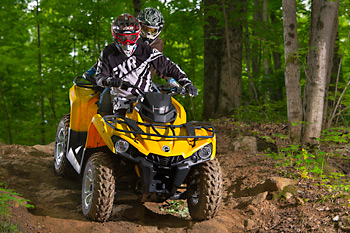Pressure on ATV sales from the burgeoning SxS market is intense. Check out the price of a Ranger or RZR at the low end and it’s not hard to see why more and more ATV buyers are opting for a SxS. This isn’t a trend anymore; it’s more like a landslide.
With this reality bearing on the ATV market, the need for high value, competitively priced ATVs is paramount. Clearly, the best way to sell more ATVs in the face of the SxS revolution is to make sure lower priced models deliver exceptional value.
It’s taken quite a while, however, we’re convinced the arrival of the “L” series of Can-Am’s successfully crosses the price-value bridge. The company has wisely responded to a legion of dealers literally begging for competitively priced models.
In the past, Can-Am refused to make excuses for its comparatively steep asking prices. With the arrival of the “L” series, Can-Am is packing a powerful punch in what is rapidly becoming the meat of the market again: The 450-550 4×4 Sport-Utility segment.
The new 450 Rotax 4-valve single powering this new Max Outlander is impressive. The engine is exceptionally torquey but it can rev-out nicely, too, when held wide open. It delivers a near-60 mph (100kmh) top end. The best part of the engine’s personality is its trail-willing throttle response. You can drive this 450 aggressively on twisty trails with the throttle. The rear wheels will spin and slide around tight turns with little more than throttle massaging as a result of copious low-end power.
Maybe you’re wondering if a 450 Outlander Max can be any fun with two on board? You bet it can! In fact, this long wheelbase ride made no excuses the entire time we were wringing it out with either one or two aboard. The engine has ample torque to pull steep grades and long WOT (wide open throttle) pulls on fire roads. It does so with snappy, responsive power at both ends of the RPM range.
What are you not getting with an Outlander L? Not that much. This particular one came with the optional DPS (Digital Power Steering) package including nice cast aluminum wheels. It didn’t have the handguards and bush bars an XT comes with and it uses a downscaled digital gauge package. The racks are steel without any composite covering and it uses a conventional key, not the DESS electronic encoded key. That’s the stuff it doesn’t have, and honestly, we didn’t miss the upscale goodies at all.
When it comes to what the “L” does deliver in the face of stiff industry competition, the tally is impressive. There’s a premium Visco-Lok differential, selectable 4×4, single lever disc brakes with braided steel hoses, a hitch receiver, nice backrest, Can-Am’s stout CVT with a hi-low range sub tranny, winch pre-wiring, and it’s all built on the Can-Am G2 chassis with revised twin trailing arm geometry and double A-arm IFS.
Unless you want to spend more money – solely because you’ve got more money – we see no one missing the 450 in XT clothes. Fact is, “L” is the only way you get a 450 in either Max or standard length. The overall build quality is extremely good. There’s a tight, solid feel to this ATV and you’ll experience this tangible quality the moment you fire up its 450 Rotax.
We could only generate one gripe with the 450 and it was consistently harped on. The sub-tranny shifter for hi/lo/reverse is a reluctant device when shuttling from forward to reverse in tight situations. The lever requires herculean force to move and everyone agreed it feels like you’re bending something while you apply Incredible Hulk bicep force to the lever. We know Can-Am can do better.
This all-new ATV is entering a white-hot marketplace dominated by the Polaris off-road juggernaut. Putting the “L” on the ATV industry’s most intense battlefield could be risky for Can-Am. On the other hand it could be the vehicle that finally gives Polaris an honest run for its money.




